“I am slightly inhuman … All I ever wanted to do was
to paint sunlight on the wall of a house. ”
Edward Hopper
Edward Hopper (1882-1967) is considered the most important realist painter of the twentieth century in the United States:
his sunny countryside where colonial houses stand out against a still sky, petrol pumps that seem to rise into naught, solitary provincial railway stations or interior scenes suspended in the incommunicability of the characters that inhabit them are imposed in collective imagination as one of the most persistent stereotypes of the disillusionment of the American dream. During his long career, the artist focused on the infinite atmospheric and luminous variations of a relatively small number of subjects engaging all genres of painting except the still life with an unmistakable expressiveness that finds in silence and existential loneliness its dominant modalities.The new exhibition at Palazzo Fava, organized by Arthemisia Group and Genus Bononiae, leads to Bologna, for the first time, 60 works of the American master from the Whitney Museum of American Art in New York which, thanks to the legacy of the widow Josephine, hosts the most conspicuous collection of his paintings, drawings and engravings. The retrospective documents the entire span of his artistic production retracing the years of academic training, his stays in Paris, the classic period of the 30s, 40s and 50s and the intense images of maturity according to a thematic and chronological order that takes into examining all the techniques practiced by him with particular attention to the relationship between the preparatory drawings and paintings.
The intention of the curators is to allow visitors to immerse the glance in the airy plein air that evoke the legendary spaces of the New World and to penetrate in the claustrophobic bourgeois interior completing using their imagination the stories that all outstanding actions of the characters seem to suggest. The uninterrupted success of these masterpieces demonstrates the extraordinary relevance of Hopper’s poetics that throughout the twentieth century worked in a cultural loneliness condition choosing to remain faithful to figurative painting in a historical juncture which decreed the explosion of abstract and gestural avant-gardes. His work demonstrates how it was possible to do research also using traditional methods of painting in its canonical development from preparatory sketch, detail study to a final image which doesn’t show any trace of the processes that have contributed to its realization. The apparent simplicity and the effectiveness of his images are the result of a slow sedimentation of brush strokes on an impeccable drawing: the absence of repentance and the perfectly calibrated color overlay in fact determine the incomparable brilliance of his painting that seems to let the light shine through every layer. Even the enigmatic realistic quality of the compositions is originated from drawing in its double valence of catalog where memories become a starting point for the next minimal and atmospheric reworking and of verification of imagination in the studies that portray his wife taking on the features of the characters represented in paintings.The influence of his language, not immediately apparent in the works of his contemporaries, has deeply conditioned the stylistic landings of other visual disciplines such as cinema and photography, where his metaphysical metropolitan settings, the visual description of silence and three-dimensional rendering of an immobilized moment began to appear as quotes or sources of inspiration. The cold and essential look through which he examined reality to return it with immediacy and without judgment has also pioneered important outcomes of a raw hyper-realism that is echoed in Duane Hanson’s disturbing polyester painted sculptures or Eric Fishl’s pictorial voyeurism.
Therefore the exhibition in Bologna brings out the so-called “hopperian figure” going back to the roots of its conception, the small format paintings made in the first decade of the twentieth century during the repeated residencies in Paris. The initial palette of dark tones was there seduced by the charm of the masters of Impressionism, especially Manet and Degas, and progressively cleared to evoke dilated and suspended atmospheres inhabited by grotesque expressionist figures. Finally returned to New York in 1910, his new style was not appreciated in homeland because it was considered too xenophilous for a conservative and nationalist culture that attributed the main cause of social and moral drift to the waves of immigration from Europe. It was then that he began to realize the American pictures that made him famous hybridizing impressionist suggestions with a cinematographic suspense and with the objective description of the rural and urban landscape of the country that in those years was building the political and economic foundations of its worldwide rise. In the meeting between the study of atmospheric brightness and the geometric layout balance that pervades the composition he built over the years his unmistakable oblique perspective that turns the everyday banality in a surreal vision dividing the frame into shady
Edward Hopper.
a cura di Carter E. Foster e Luca Beatrice
25 marzo – 24 luglio 2016
Palazzo Fava – Palazzo delle Esposizioni. Via Manzoni, 2 Bologna
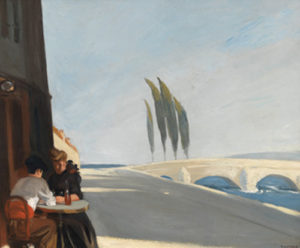
Edward Hopper, Le Bistro or The Wine Shop,1909, Oil on canvas, 61x 73,3 cm Whitney Museum of American Art, New York; Josephine N. Hopper Bequest © Heirs of Josephine N. Hopper, Licensed by Whitney Museum of American Art
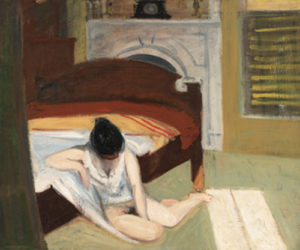
Edward Hopper, Summer Interior,1909 Oil on canvas, 61,6×74,1 cm Whitney Museum of American Art, New York; Josephine N. Hopper Bequest © Heirs of Josephine N. Hopper, Licensed by Whitney Museum of American Art

Edward Hopper, Cape Cod Sunset,1934 Oil on canvas, 74x 92,1 cm Whitney Museum of American Art, New York; Josephine N. Hopper Bequest © Heirs of Josephine N. Hopper, Licensed by Whitney Museum of American Art
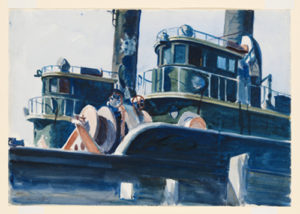
Edward Hopper, Two Trawlers,1923 1924 Watercolor and graphite pencil on paper, 35,2×50.6 cm Whitney Museum of American Art, New York; Josephine N. Hopper Bequest © Heirs of Josephine N. Hopper, Licensed by Whitney Museum of American Art
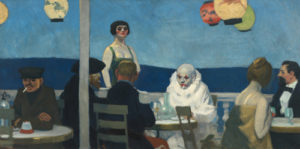
Edward Hopper, Soir Bleu, 1914, Oil on canvas, 91,8×182,7 cm, Whitney Museum of American Art, New York; Josephine N. Hopper Bequest 70.1208 © Heirs of Josephine N. Hopper, licensed by Whitney Museum, N.Y. Digital Image © Whitney Museum, N.Y.
Graduated in art history at DAMS in Bologna, city where she continued to live and work, she specialized in Siena with Enrico Crispolti. Curious and attentive to the becoming of the contemporary, she believes in the power of art to make life more interesting and she loves to explore its latest trends through dialogue with artists, curators and gallery owners. She considers writing a form of reasoning and analysis that reconstructs the connection between the artist’s creative path and the surrounding context.


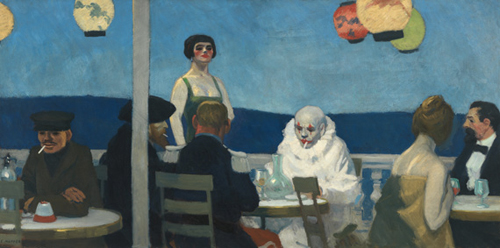




NO COMMENT